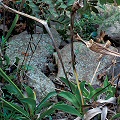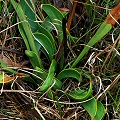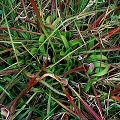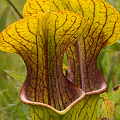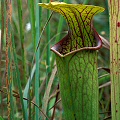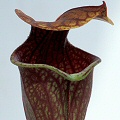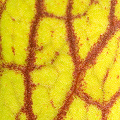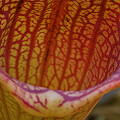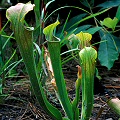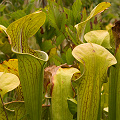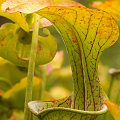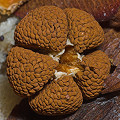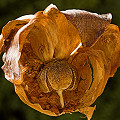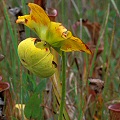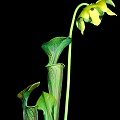Q: About Sarracenia oreophila, the green pitcher plant
A: Sarracenia oreophila is a very rare pitcher plant that, unlike most
of the more common species, is found only far inland, mostly in the hilly central and northern parts of Alabama.
In
overall form, Sarracenia oreophila is very similar to Sarracenia flava
and in fact was considered a mere variant of it
(i.e. S. flava var. oreophila Kearney),
until it was given its current name by E.T. Wherry. The main differences I see that separate the two species, other than the obvious
differences in range, are the following.
1)The pitcher lip of S. oreophila is not as elaborately huge, or as exaggeratedly spouted.
2)The column supporting the lid is not as slender or tall as it is in S. flava.
3)The lid of S. oreophila is often convex (instead of concave), and does not have as large a
tendril at the tip.
4)During the winter, S. oreophila produces recurved (not straight) phyllodia.
5)The flowers have a much more subdued smell, but have the same range of color, i.e. green to mustard yellow.
One interesting character of this species, but not one that is very desirable for horticulturists, is that the pitchers often
die off long before summer is even half over. The pitchers are a little more papery and flimsy than those of
S. flava, and simply do not have the same staying power.
Varieties
Do not, in any way, trust that old story that S. oreophila is pale or boring in coloration. I have
seen specimens with many of the same color variations that are expressed in S. flava! However, only two
varieties have been named.
Sarracenia oreophila var. oreophila
This is the standard variety, and can be variously veined or blushed with color. However, the venation on the outer portion of the
pitcher is weaker, and almost always absent from the pitcher lid. The pitcher tube venation is reticulated--and that is critical.
Sarracenia oreophila var. ornata
As you might expect from the name, this is the more ornate form. The venation is strong, reticulated (as opposed to mostly
pinstriped), and can even be found on the pitcher lid. The pitcher may be deeply suffused with red or purples. Very nice.
Range
States: North Carolina, Alabama, Georgia.
In Georgia, Sarracenia oreophila is only found in one site in Towns County, in the
north part of the state. A
second, very small site may have once occurred in Clay County but conversations with local conservation
workers and Natural Heritage staff indicate it no longer exists. Claims that it occurs in Taylor county (south-central Georgia) are controversial in the literature,
and are complicated because of the presence of a
strange variant of S. rubra subsp. gulfensis in the region.
However, Sheridan & Patrick (2003) report on evocative historical letters that suggest that H. Neisler observed this plant
in Taylor County in the 1850s.
In North Carolina, Sarracenia oreophila is only found in one site (Clay County). The remaining
20 sites are all in Alabama, in (I believe) the Coosa Valley area (Etowah and Cherokee Counties), and the large area
called Sand Mountain (Dekalb, Jackson, Marshall and again Etowah Counties) which is really an extension of the Cumberland
Plateau. Do not ask me for more detailed information than this; I will not provide it for poaching
reasons.
(Please do not write angry letters that I should not be revealing location information at the county level as I am doing---this
information is in countless scientific publications, books, and web sites maintained by the Forest Service,
Heritage Programs, etc.)
And once again, I come to the issue of the number of sites for this plant. I cite 20 Alabama locations, but I have read
estimates of as many as 34 sites. The reason for the discrepency is that while one scientist might decide that all the sites
within a short bee flight should be logged as a single site, someone else might count all the subsites as separate.
Do not fret if you see differing numbers in publication.
It is interesting that this species occurs so far inland, in conditions that are at times truly mountainous. It actually occurs
in three different kinds of sites. The first is a flatwood site where water pools above an impermeable ground layer. The second
site is a seepage bog, and the third site is a streamside bog. In the latter two situations, ground water is forced to the
surface. The water budget for such seepage or streamside sites is often very delicate and can easily be damaged by
drainage tiles, irrigation, and other uses.
Sarracenia oreophila, like Sarracenia jonesii and
Sarracenia alabamensis subsp. alabamensis, is listed as "Endangered" by the US Endangered Species Act, and
is listed on CITES Appendix I. The FAQ entries dealing with these issues describe in detail various limitations associated
with such legal delineations.
At this point in time, habitat destruction is not a particular threat to Sarracenia oreophila
because all the sites that could easily be destroyed already have been. The remaining sites are all being managed either by
federal, state, or nonprofit organizations. Many of these sites are privately owned, and because of the wisdom and conservation
ethic of their owners, are being stewarded well. (A huge pat on the back is deserved for all the owners of existing
Sarracenia oreophila sites!!!) However, there are some significant threats even to these sites. First,
they must be maintained in an open, sunny situation. Prescribed fire must be used frequently to mimic the fire
regime that existed before the sites were so heavily fragmented. Non-native species must be managed. Hydrology must be maintained.
These tasks are not easy! Furthermore, it really is a difficult situation when, as is the case at some locations, the
Sarracenia oreophila site is a tiny postage-stamp parcel, surrounded on all sides by roads and
development. At what point is the area no longer a natural site?
To help manage some of these sites, when I was Director of Conservation for
the International Carnivorous Plant Society, I helped divert funds to support conservation efforts in
North Carolina and Alabama. I don't think this work is being funded anymore, alas.
Unfortunately, it is difficult for horticulturists to see this plant in the
wild because of poaching problems. I have no good advice for you.
I have seen lots of sites, but that is in part because I have dedicated my life to conservation.
Horticulturally, S. oreophila is a little uncommon because it is so difficult to obtain and
also because its long dormancy makes it a somewhat slow grower. There are some clones which are extremely weedy in cultivation, and so,
alas, they are not very pretty. There is a story, started by Slack, that hybrids involving these plants tend to be larger than
comparable hybrids made with S. flava, but I have not seen this. A single specimen of
S. oreophila was established as a cultivar, but unfortunately it was not propagated soon enough and,
during a greenhouse catastrophe, the only existing specimen of S. oreophila 'Don Schnell' perished.
(So stop emailing me, asking where you can get this plant---it's GONE!)
Page citations: CITES, 1992; Determann, R. 2000, private communication;
Estes, D. 2006; Kartesz, J. et al. 2009 (BONAP); McDaniel, S. 1971;
McPherson, S. & Schnell, D. 2011;
Murdock, N. 2000, private communication; Rice, B.A. 2000b, 2001a, 2006a; Schnell, D.E. 2002a;
Sheridan & Patrick 2003; Slack, A. 1979, 1986; US Fish &
Wildlife Service, 1973.
